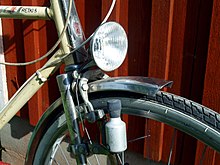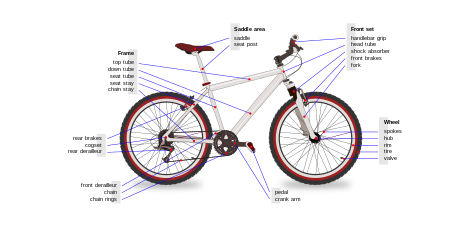

On a bicycle, a fender American English or mudguard British English is a part that encloses a tire so that it stops spray of water, sand, mud, stones and other road debris from thrown into the air by the rotating wheel.[1] Full-covering fenders[2] go over most of the upper side of the tire, and are considered standard equipment on utility bikes.[3] Sports bikes can have smaller fenders or be completely fenderless, especially on bikes made for use in drier climates.
Fenders (mudguards) have an additional cost and contributes to extra weight on the bike, but have the benefits of keeping the cyclist's legs, trousers and back drier, as well as preventing paint damage,[4][5] preventing eye damage to passengers in bicycle trailers,[6] and being able to provide lower aerodynamic drag.[7][8] The spray can be clearly noticed when cycling behind another rider in wet conditions, such as when cycling in pelotons, and some clubs require the use of a rear fenders when training in the winter.[9]
To mount fenders, there must be enough clearance between the wheels and the fork and frame, and the choice of tires also has an impact on how much space there is for fenders. There are no standards for fenders, but there are adjustable models on the market that can be adapted to fit several bikes. Some bikes have eyelets on the frame and fork for securely attaching fenders, or manufacturers make some which attach to the bicycle with e.g. rubber bands.[10] Alternatively, some rear fenders can be fitted to the seatpost.
See also
References
- ^ Jennifer (2019-11-20). "Do You Need Mudguards on a Road Bike?". Retrieved 2023-06-29.
- ^ "Ett gir – null problemer – Cargobike Magazine".
- ^ "Bestemor vet best: 15 idiotsikre utstyrstips – Cargobike Magazine".
- ^ Marlowe, Rob. "Do Bike Fenders Actually Work? (Here's the Truth)". Retrieved 2023-06-29.
- ^ Bassett, Erik (2021-04-17). "Your Bike Probably Needs Fenders (But Here's How To Know) - Two Wheels Better". Retrieved 2023-06-29.
- ^ "(PDF) Transportation of children with bicycle seats, trailers, and other carriers: considerations for safety".
- ^ Marlowe, Rob. "Do Bike Fenders / Mudguards Slow You Down? (Explained)". Retrieved 2023-06-29.
- ^ "Mudguards are MORE aero: study shows that optimum drag reduction is achieved with mudguards on". 2019-10-31. Retrieved 2023-06-29.
- ^ "Best road bike mudguards 2023 — choose fenders that'll keep you dry and comfortable on wet rides". 2023-03-13. Retrieved 2023-06-29.
- ^ updated, Simon Smythe last (2021-04-01). "Best bike fenders / mudguards for autumn and winter 2023". Retrieved 2023-06-29.



Recent Comments